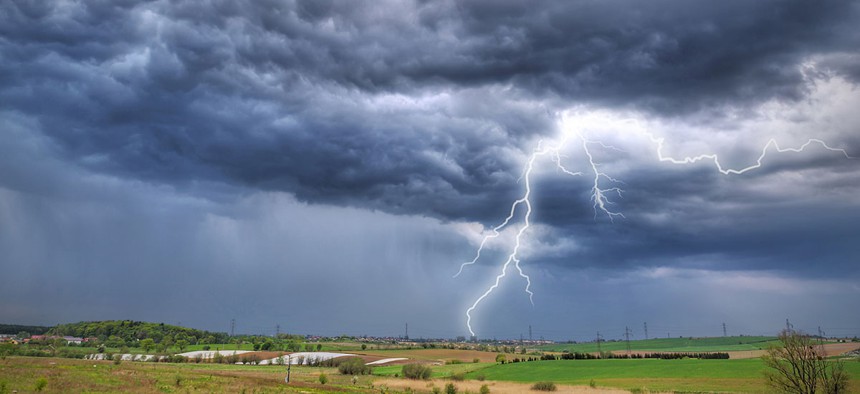How Phones Can Help Predict Thunderstorms

Patryk Kosmider/Shutterstock.com
A meteorologist is harnessing data from the devices’ barometers to improve local forecasting.
If you have a smartphone, chances are one of the first things you do in the morning is check the weather—but whatever your app of choice, the forecast you see probably is based on information from the government. Most apps use data from the National Weather Service as a baseline, and some rely on tweaks to that data from companies like the Weather Channel.
Those services are good at predicting the weather tomorrow or next week, but can falter in the shorter term: Government satellites aren’t so great at guessing the precise moment when rain will start pouring out of those angry clouds overhead.
One of the best ways to improve the quality of short-term forecasting is to rely on sensors on the ground that report data like barometric pressure, which can help scientists determine when the weather’s about to change. These sensors are already being used to help forecasters predict the weather, but in some areas, they’re few and far between.
In the last five years, however, the number of pressure sensors in the world has exploded. That’s because smartphone manufacturers have started putting them in their phones, mainly to help determine a device’s altitude for location tracking: Samsung’s Galaxy smartphones have packed barometers since 2011, and the feature came to Apple’s iPhone 6 and 6 Plus in 2014.
Despite the sensor’s prevalence—a good chunk of the nearly 3 billion smartphones in the world now have one—meteorologists haven’t yet been able to take full advantage of its potential.
Developers and weather forecasters have been talking about using smartphone sensors for years, but neither Apple’s iOS nor Google’s Android operating systems make available the pressure readings taken by their smartphones. And so far, weather apps have only been moderately effective in harnessing the smartphone sensors.
Last year, a popular weather app called Dark Sky introduced an opt-in feature that automatically takes barometric pressure readings.
“We get more than a million pressure sensor reports a day, and it’s growing,” said Dark Sky’s founder, Adam Grossman, in an email. “We’re still very much in the experimentation phase when it comes to using the data, but we’re optimistic that it’ll be used in our forecasting in the not-too-distant future.”
Another app, WeatherSignal, takes automatic readings and sends it to a number of academic partners, according to Brendan Gill, the app’s founder. One of those partners is Cliff Mass, a professor and meteorologist at the University of Washington, who has been writing about the potential of smartphone readings to change weather forecasting on his blog and in academic journals since 2012.
For now, Mass says, he gets about 5,000 to 10,000 readings an hour from WeatherSignal, which he’s combined with a few other data feeds—including one from an app coded by one of his grad students—to fine-tune the algorithms he’s developed to simulate weather patterns.
Pressure observations are particularly useful for figuring out traditionally hard-to-predict weather events, Mass said—detailed pressure readings might reveal the atmospheric subtleties that tend to precede a storm, for example. The data could also help lead to better predictions of shifts in the winds.
“Errors of an hour or two in timing in a wind shift line could be worth huge amounts of money for wind farms,” Mass said.
But to be successful, researchers need a whole lot more readings, especially in less populated areas in places like the Midwest.
“What we’ve shown is that even moderate density helps. But I’d like to have a whole order of magnitude—or two orders of magnitude or three orders of magnitude—more observations, and I’m hoping that could provoke revolutionary improvements in forecasting these smaller-scale features,” Mass said. “If I could get a density of one [sensor] per square mile in rural areas, that would be a big advance.”
Last year, Mass spoke extensively with Google about harvesting barometric data from the vast network of pressure sensor-equipped Android smartphones for his research. The talks got a long way, he said, but ended up falling apart. Google was not immediately available for comment.
But he’s found another alternative to serve as his data firehose: The Weather Company. He’s been working with the IBM-owned company, which is the parent of the Weather Channel and Weather Underground, to gather data from its extremely popular iOS and Android apps.
Currently, he’s getting about 75,000 reports an hour from users who have opted to regularly report the ambient pressure around them, said Peter Neilley, senior vice president for global forecasting services at The Weather Company.
But that number could go way, way up.
“We’re only touching the tip of the iceberg here,” Neilly said. “It’s pretty easy to imagine a pathway where we could get to a billion observations per day, and that’s what I aspire for.”
The company has been sharing data for about a year—and has provided Mass’s team with some funding—but has battled technical problems that have rendered the data unusable. Neilly and Mass say those should be cleared up in the near future.
For now, the information only goes in one direction: from The Weather Company to Mass’ Seattle lab. There, Mass is working on creating the tools that might one day soon end up in the software that drives the predictions on The Weather Company’s website and apps. That could happen within the next year, Neilly said.
Given that modern smartphones bristle with sensors, why such a focus on the barometer? Pressure data is the only variable a smartphone can sense that’s useful for forecasting, Mass says: Temperature readings, for example, are affected by battery heat and location.
“Pressure is actually a fairly unique observation,” Neilly said. “Even though you’re measuring pressure at the ground, pressure is sort of a culmination of all things that are going on above you.”
But it’s important to thoroughly anonymize the readings if they’re going to be sent to a third party. Because barometric pressure can reveal a person’s altitude—one of the three pieces of information that are needed to locate a point in three-dimensional space—it can help someone piece together a device’s location.
What’s more, future versions of the data-gathering app may string together a phone’s pressure readings under a random identifier and pair them with location information in order to improve accuracy, which could reveal an individual device’s daily travel patterns.
“Altitude is potentially as sensitive as other geolocation information, which is highly sensitive,” said Joseph Lorenzo Hall, chief technologist at the Center for Democracy and Technology, in an email. He recommended trying to convince businesses or the government to take the readings to avoid invading smartphone users’ privacy.
Neilly says the program will remain opt-in and completely anonymous.
“We’re very, very careful to make sure there’s no way this data can be used to track back to any individual,” he said.
If they’re properly treated and carefully guarded, crowdsourced barometric readings can make hyperlocal weather forecasts more accurate—and in return for sharing their data, smartphone users might soon have help avoiding a surprise drenching.
NEXT STORY: House panel wants update on Census IT risks



